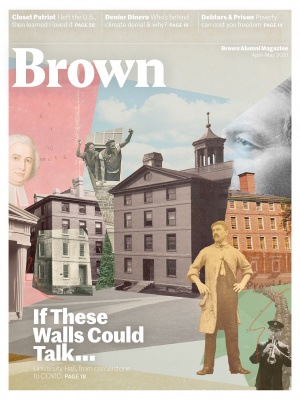When we made the decision to transition to remote operations in March 2020, we never imagined that, a year later, we would still be managing through the COVID-19 pandemic. We also never imagined we would be able to conduct so many aspects of our mission successfully, even in these extraordinary times. Throughout the course of the pandemic, the Brown community has demonstrated extraordinary resilience, creativity, and dedication.
When we began the fall 2020 semester, we gave students the choice to return to campus or study remotely. The dispersion of our students, literally across the globe, necessitated that we adopt a mixed model of teaching. Larger classes were offered fully online. Smaller classes, with 19 or fewer students, could be offered in person. But even in-person classes had to be a hybrid model, still accessible to students studying remotely.
Faculty who, a year ago, couldn’t have imagined educating their students in online and hybrid formats, spent time and thought reinventing how to deliver their courses. The result, based on student feedback surveys, has been even greater student fulfillment. In fact, students are reporting that they’re learning more, spending more time on their coursework, and attending class more frequently than they were prior to the pandemic.
This is largely the result of the concerted efforts of our faculty and staff, who swiftly rose to the challenges we faced. Last summer, we made technology upgrades to 90 classrooms to support hybrid learning. While technology was key in this adaptation, it was far from the only aspect of innovation. We simultaneously worked with faculty through the Harriet W. Sheridan Center for Teaching and Learning to offer the professional development needed to support and inspire this successful transition.
The Sheridan Center launched the Anchor Program, an institute designed to prepare faculty to develop powerful and engaging fully online and hybrid courses. To date, this program has helped more than 300 faculty members from a wide range of disciplines design courses that maintain the goal-directed and student-centered learning experience that is central to a Brown education. What’s more, faculty are designing resilient courses adaptable to a range of student needs and teaching formats.
Students report they’re learning more and spending more time on their coursework than they were prior to the pandemic.
Through this program, faculty considered how to help students stay engaged in learning at a time when many were spending significantly more hours at their computers. Long lectures are replaced with short videos and readings that connect directly to learning goals.
A priority has been retaining the vibrant exchanges between students that characterize in-person classes. Techniques include the use of message boards and chat features to complement in-depth discussions. Faculty also learned how to use virtual “breakout rooms” to stimulate conversation and encourage students to engage creatively with course materials.
These efforts have altered, perhaps permanently, the way Brown faculty teach. Faculty report that the challenges of teaching in a pandemic have encouraged them to be more experimental and conscious of the need to adapt teaching methods in consideration of students’ needs. Many believe that they will be more effective educators, regardless of the setting. And others are intrigued by the possibility of using these tools to reach more students, in a wider set of locations, even after the pandemic is over.
There’s no doubt that the pandemic has imposed stress on our community, and we are eagerly awaiting the day when faculty and students can gather in-person with fewer restrictions to enjoy discussion and debate. (And I hope that by the time this issue of the BAM arrives, that day will be in sight.) But the pandemic has also shown us the benefits of broadening our approach and more deliberately considering the learning needs of our students.
As Renée Ater, a Provost’s Visiting Professor in Africana Studies and participant in the Anchor Program, recently noted, “I will never go back to lecturing in a dark classroom ever again.”
Read the April–May 2021 President's Spread on "Pandemic-Era Guidance for Educators" here (PDF)





